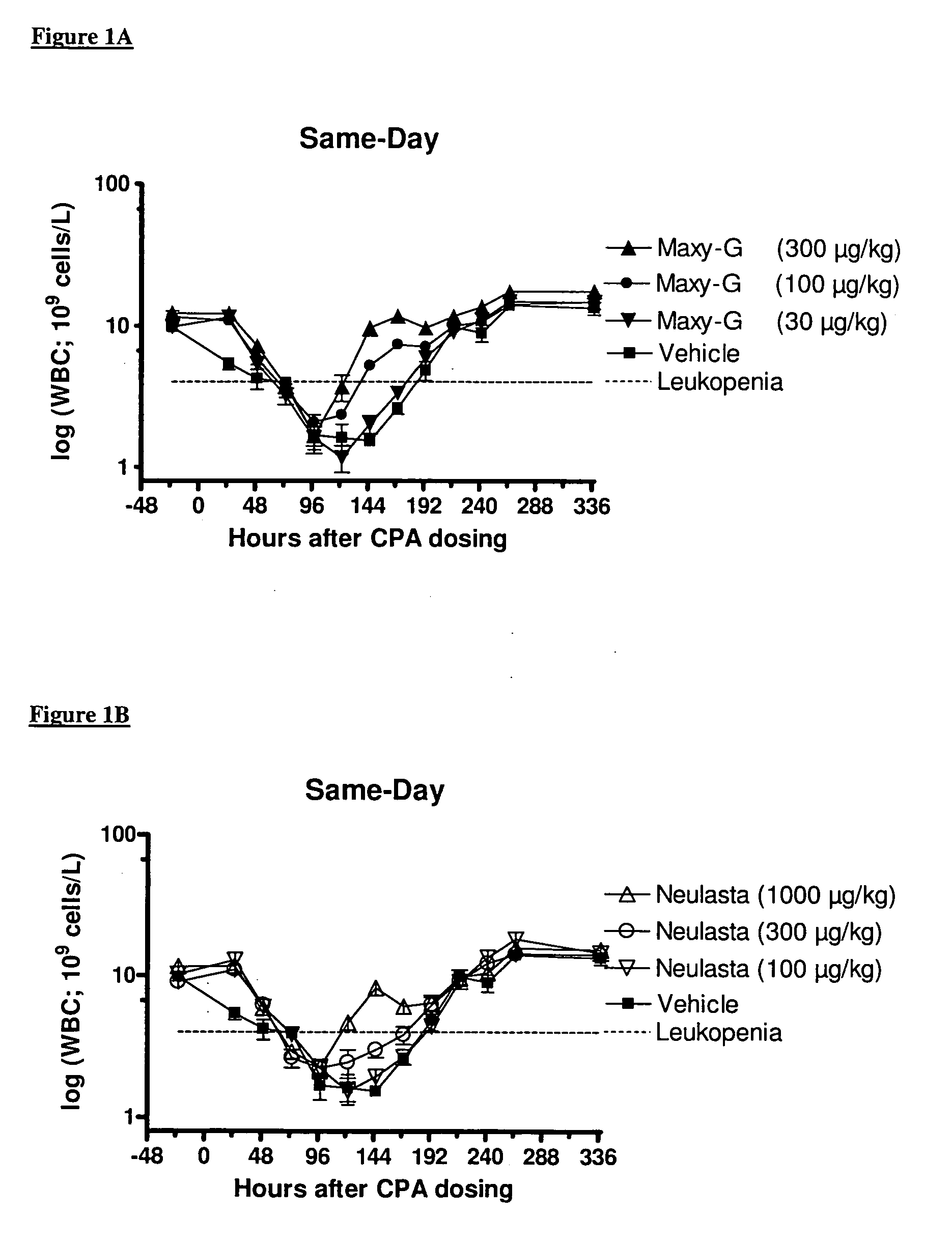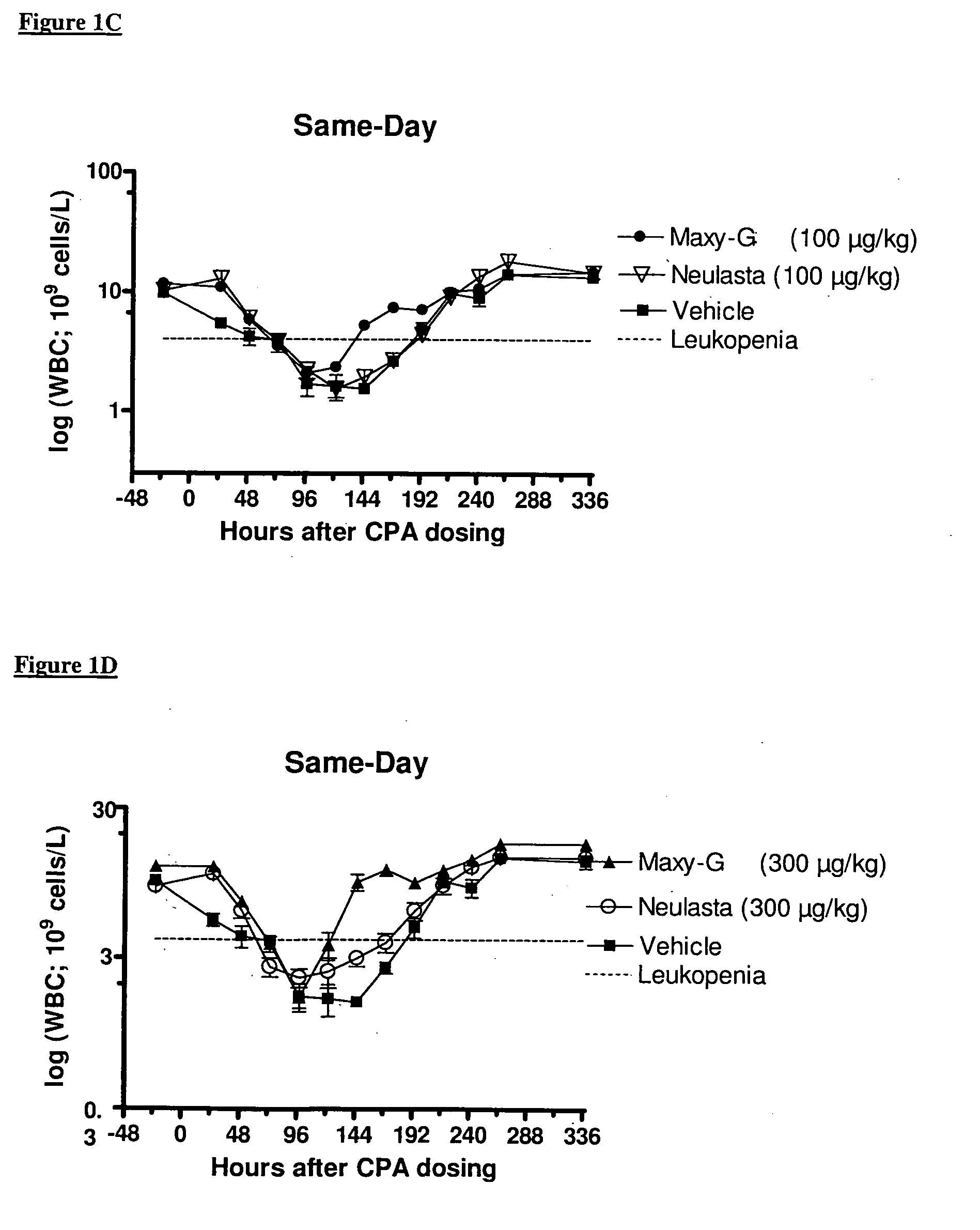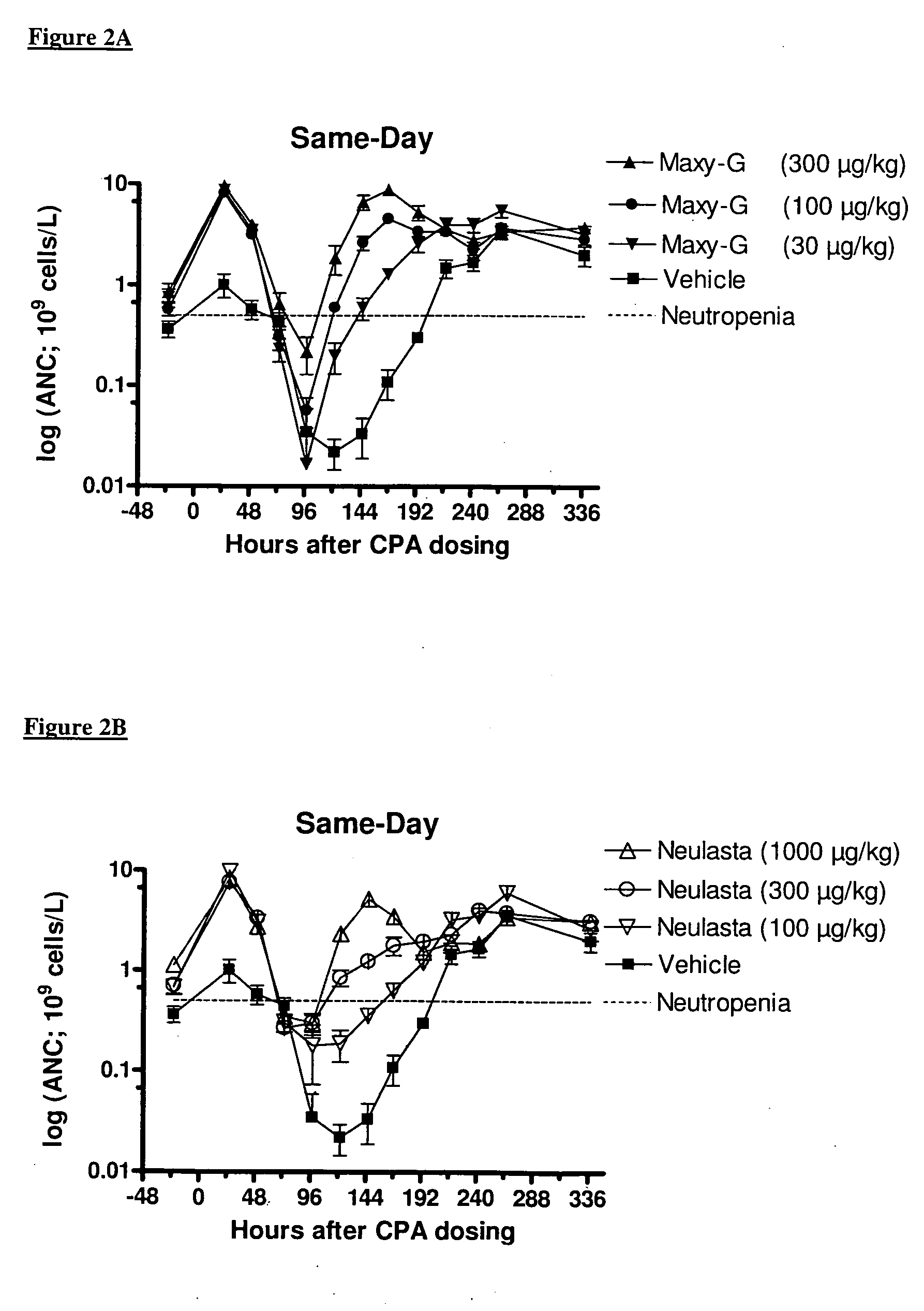Method for the treatment of neutropenia by administration of a multi-pegylated granulocyte colony stimulating factor (G-CSF) variant
a technology of granulocyte colony and neutropenia, applied in the direction of antineoplastic agents, peptide/protein ingredients, pharmaceutical non-active ingredients, etc., can solve the problems of significant disadvantage for chemotherapy patients, not being approved for administration simultaneously, and relatively minor infections serious and even life-threatening, so as to reduce chemotherapy-induced neutropenia, treat or prevent neutropenia, and prevent neutropenia
- Summary
- Abstract
- Description
- Claims
- Application Information
AI Technical Summary
Benefits of technology
Problems solved by technology
Method used
Image
Examples
example 1
Measurement of Pharmacokinetics of PEGylated G-CSF Molecules in Normopenic Rats
[0179]The pharmacokinetics of a PEGylated G-CSF molecule in normopenic (i.e., healthy) rats is measured as follows. Male Sprague Dawley rats (7 weeks old) are used. On the day of administration, the weights of the animals are measured (generally, 280 to 310 gram per animal). 100 μg per kg body weight of the PEGylated G-CSF samples are each injected intravenously into the tail vein of three rats. At 1 minute, 30 minutes, 1, 2, 4, 6, and 24 hours after the injection, 500 μl of blood is withdrawn from each rat while under CO2-anesthesia. The blood samples are stored at room temperature for 11 hours followed by isolation of serum by centrifugation (4° C., 18000×g for 5 minutes). The serum samples are stored at −80° C. until the day of analysis. After thawing the samples on ice, the serum concentration of G-CSF is quantified either by a G-CSF in vitro activity assay (such as the in vitro assay for G-CSF activi...
example 2
Same-Day Administration of PEGylated G-CSF and Cyclophosphamide
[0185]A study was performed to evaluate the ability of same-day administration of a multi-PEGylated G-CSF variant to counteract or minimize the period of neutropenia induced by Cyclophosphamide, a chemotherapeutic agent, in male rats, and to compare the effect to that of the mono-PEGylated G-CSF, Neulasta® (pegfilgrastim).
Materials and Methods
[0186]Animals: Fifty-four (54) male, Sprague Dawley rats (M&B Taconic) weighing approximately 190 g were used in the study.
[0187]Chemotherapeutic agent: Cyclophosphamide (CPA) was prepared at a concentration of 33.33 mg / mL by dissolving 1000 mg Sendoxan (Baxter Oncology, Halle, Germany) in 30 ml 0.9% normal saline.
[0188]Reference mono-PEGylated G-CSF: Neulasta® (pegfilgrastim; Amgen, Thousand Oaks, Calif., USA) was formulated in 10 mM Na-acetate containing sorbitol (50 mg / mL) and Tween-20 (33 μg / mL) at concentrations of 100, 300 and 1000 μg / mL.
[0189]Test multi-PEGylated G-CSF varian...
example 3
Same-Day Administration of PEGylated G-CSF and Paclitaxel
[0211]A pilot study was performed to evaluate the ability of a multi-PEGylated G-CSF variant to counteract or minimize the period of neutropenia induced by Paclitaxel, a chemotherapeutic agent, in male rats, and to compare the effect to that of the mono-PEGylated G-CSF, Neulasta®.
Materials and Methods
[0212]Chemotherapeutic agent: Paclitaxel (Taxol, 6 mg / mL)
[0213]Reference mono-PEGylated G-CSF: Neulasta® (see Example 2)
[0214]Test multi-PEGylated G-CSF variant: “Maxy-G” (see Example 2)
[0215]Vehicle: 10 mM sodium acetate, pH 4.0, 45 mg / mL mannitol in water for injection,
0.05 mg / mL Tween 20.
[0216]Animals: Sprague-Dawley rats; age at initiation of treatment: approximately 6 weeks; approximate body weight range at initiation of treatment: 170-220 g; pelleted complete diet and water ad libitu m; main group: 50 males; satellite animals for bioanalysis: 30 males.
[0217]Experimental design: On day 0, the animals were treated with the che...
PUM
 Login to View More
Login to View More Abstract
Description
Claims
Application Information
 Login to View More
Login to View More - R&D
- Intellectual Property
- Life Sciences
- Materials
- Tech Scout
- Unparalleled Data Quality
- Higher Quality Content
- 60% Fewer Hallucinations
Browse by: Latest US Patents, China's latest patents, Technical Efficacy Thesaurus, Application Domain, Technology Topic, Popular Technical Reports.
© 2025 PatSnap. All rights reserved.Legal|Privacy policy|Modern Slavery Act Transparency Statement|Sitemap|About US| Contact US: help@patsnap.com



